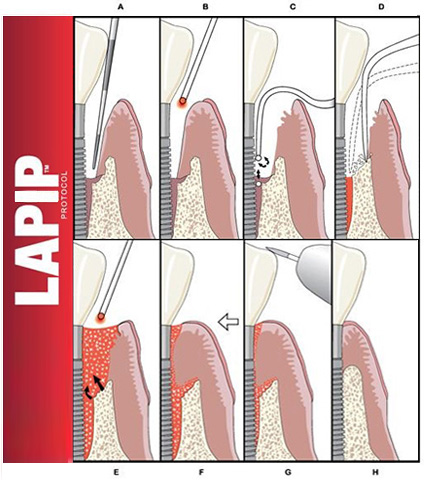LAPIP Treatment for Peri-Implantitis in Mosman
Dental implants offer a revolutionary way to replace missing teeth and have restored the dental function and smiles of millions of people around the world. However, what many do not realise is that just as you can get infection in the gum and bone around teeth (periodontitis) you can also get infection in the gum and bone around dental implants (peri-implantitis).
As with most dental diseases, early diagnosis and treatment is vital in effectively addressing peri-implantitis. Dr Hugh Fleming (Dentist) with over 30 years’ experience in working with dental implants, has an in-depth knowledge and extensive experience in addressing peri-implantitis with Laser Assisted Peri-Implant Protocol (LAPIP).
This procedure employs a specific laser which:
- Targets and eliminates the bacteria causing peri-implant disease
- Targets and eliminates infected gum tissue while preserving non-infected gum tissue
- Encourages new soft tissue and bone attachment to the affected implants
How Does LAPIP work?
Over one or two appointments all the affected implants in a patient’s mouth can be treated employing the LAPIP treatment protocol:
 A. Having numbed the areas to be treated, a periodontal probe is employed to determine the degree of gum infection and associated bone loss to allow the dentist to recognise the severity of infection around each implant. These measurements are also compared to the 3D x-ray assessment previously made employing Hugh Fleming Dentistry’s 3D cone beam xray technology.
A. Having numbed the areas to be treated, a periodontal probe is employed to determine the degree of gum infection and associated bone loss to allow the dentist to recognise the severity of infection around each implant. These measurements are also compared to the 3D x-ray assessment previously made employing Hugh Fleming Dentistry’s 3D cone beam xray technology.
B. A Periolase® laser vaporizes bacteria, diseased tissue and pathologic proteins causing the peri-implant gum disease.
C. & D. Ultrasonic scalers and special hand instruments are then employed to remove tartar and calculus deposits from the implant surface resulting in a clean implant surface for new tissue healing and attachment.
E. The Periolase® laser is employed on a different setting to further disinfect the clean implant surface and stimulate a fibrin clot seal around the implants.
F. Within minutes fibrin reattachment to the implant surface occurs, along with a stable fibrin clot at the gum crest, creating a closed healing environment for ongoing soft tissue and bone healing.
G. The bite forces on the affected implants are adjusted to eliminate any high spots or occlusal trauma which may delay ongoing bone healing.
H. Over time the soft tissue and bone regenerates and attaches to the dental implant.
The Benefits of LAPIP
There are many reasons to choose LAPIP treatment of peri-implant disease:
- Less pain. With no scalpel cutting or stitching, LAPIP is less invasive with less post-treatment discomfort than alternative surgical treatments.
- Fewer treatments. With just 1-2 treatments, your LAPIP procedure will be complete, compared to multiple appointments for alternative surgical treatments.
- Faster recovery time. Since LAPIP is less invasive, you will have less downtime to recover and can return to your daily activities immediately.
- Boosted bone regeneration. LAPIP is the only laser protocol scientifically proven to regenerate bone around dental implants.
- Less gum recession. The LAPIP laser distinguishes between unhealthy and healthy gum tissue and removes only the unhealthy tissue. This results in less gum recession when compared to traditional gum surgery procedures.
- Safe for everyone. LAPIP does not interfere with any medications you are taking or medical conditions you may have.
Do I Need LAPIP Treatment?
The Signs of Peri-Implant Gum Disease
Peri-implant mucositis is the first stage of gum disease around a dental implant and is caused by a build-up of plaque (a film of bacteria) that is constantly forming on teeth and implants. These bacteria produce toxins that irritate your gums, leading to red, tender, swollen gums that readily bleed when touched (flossing or brushing). At this stage people experience minimal symptoms except for bleeding gums which may be seen in blood present when you rinse your mouth out after brushing. Bad breath is also often caused by peri-implant mucositis.
Peri-implant mucositis left untreated can become peri-implantitis where the bacterial toxins start to attack the supporting bone resulting in gradual bone loss from around the implants. Depending on the degree of bone loss, bone pockets of increasing depth develop around the implants under the gums and the implant teeth show gum loss (recession), tartar formation, bleeding and puss exudate from around the dental implants. In the advanced stages implants are often lost due to complete breakdown of the supporting bone.
LAPIP therapy can benefit all stages of peri-implant gum disease and is an excellent method of treating both early and advanced cases of peri-implant infection.
Ask us for Further Information
If you have experienced any of the signs or symptoms above, do not hesitate to contact Hugh Fleming Dentistry to arrange for an assessment of your peri-implant gum disease.
CONTACT US

